Day 1 of a 3-day Summer Tour. It was a cloudy, grey and cool (for the time of year) day, with a strong N wind coming straight down the North Sea. It didn’t exactly feel like summer, but at least it remained mostly dry until later in the afternoon. We spent the day in North Norfolk.
On the drive down to the coast, a Great Spotted Woodpecker flew out from the trees by the road and bounded off over the village. Our first destination this morning was Stiffkey Fen. We parked off the road and as we got out of the minibus, a couple of Marsh Harriers drifted past.
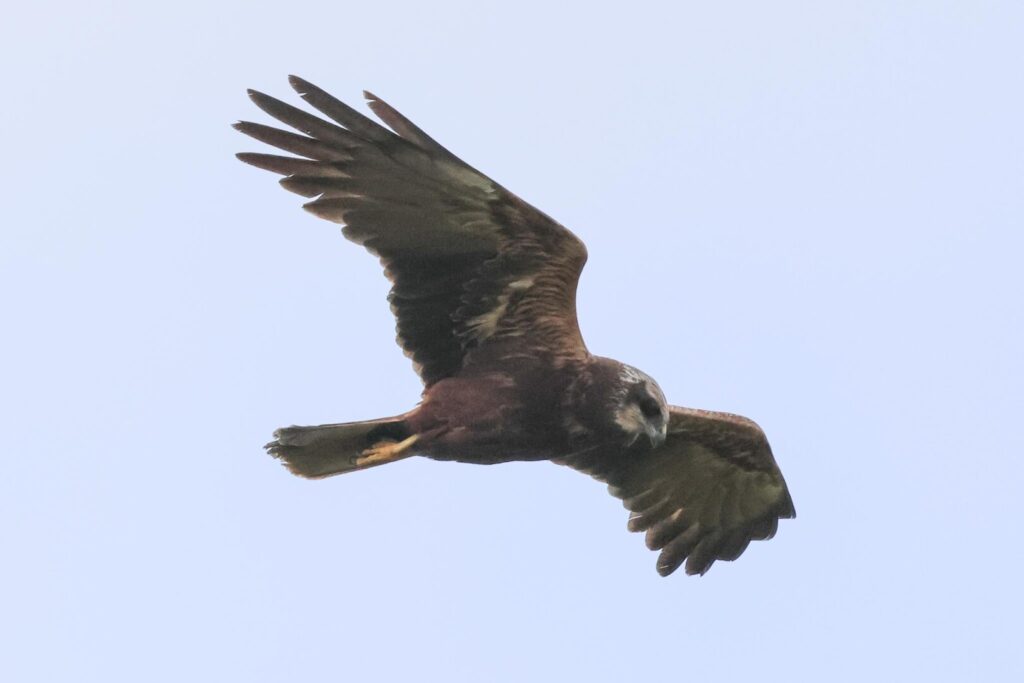
Walking down along the permissive path by the road, we could hear Chiffchaff and Blackcap singing in the small copse at the end. Along the path to the Fen, we heard Bullfinches calling and looked up to see a couple fly across over the field. Surprisingly there were a few butterflies out this morning, despite the unpromising weather – a Meadow Brown in the hedge and both Small and Essex Skippers on the thistles in the edge of the field. A Ruddy Darter was lurking in the grass.
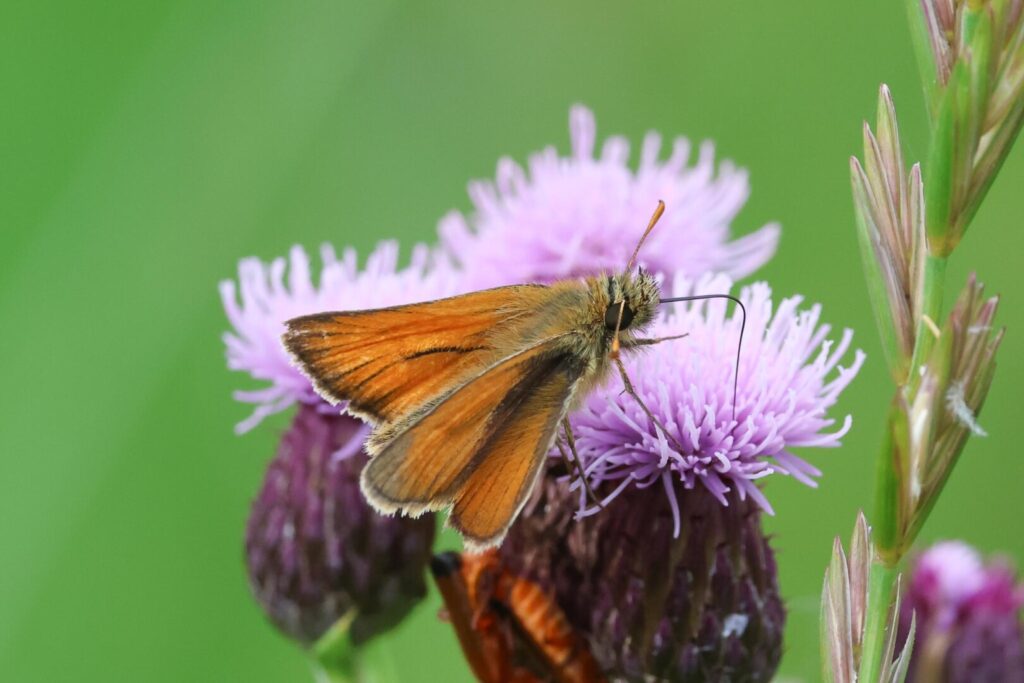
The reeds have grown so high now it is hard to see across to the Fen from the path. We could just see a large group of Spoonbills on the Fen and most of them were tucked up in the corner behind the reeds, out of the wind, where we might not be able to see them from the coast path. Birds from the breeding colony at Holkham, they gather here after they have finished breeding.
As we came up the steps onto the seawall, we spooked a Spoonbill which was feeding in the channel below. It flew up and circled round onto the Fen. Looking across the other side, thankfully we could see some of the Spoonbills on the island beyond the end of the reeds. A couple of fresh juveniles were chasing round after their parents begging to be fed, bouncing their heads up and down repeatedly.
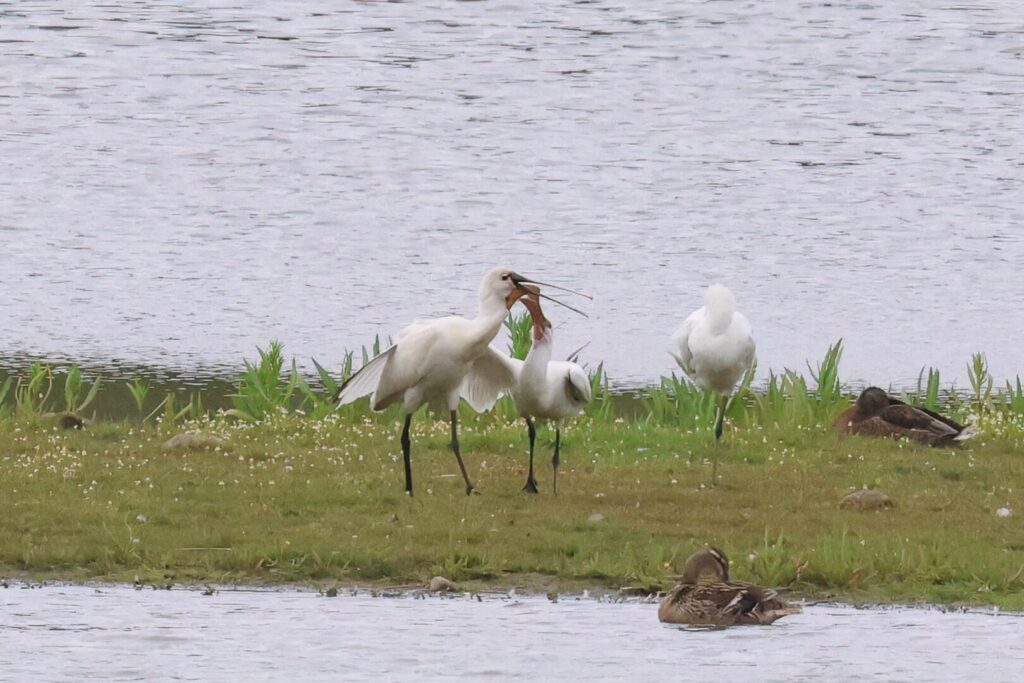
The tide was still coming in but there were already a few waders on the Fen. Three smart Icelandic Black-tailed Godwits in full rusty breeding plumage were standing in the water down at the front. Despite it being only July, autumn is here already for many of the waders – after finishing breeding attempts further north, they quickly return south. Several Redshanks were roosting in a tight group on the back of one of the islands.
More waders were still flying in, pushed off the harbour by the rising tide. A Greenshank dropped in with the Redshanks, followed by two more which landed at the front before flying flew back to join first. Seeing them alongside each other, the first was in paler winter plumage but the two were still in dark-spotted breeding plumage. More waders returning after breeding attempts further north.
There were lots of ducks roosting on the Fen, the drakes in brown eclipse plumage now, it is not the best time of year to look at them. They were mostly Mallard, but we did find a couple of Gadwall and a single moulting drake Teal in with them. Four Shoveler were feeding further back, swimming in circles with heads down in the water, in front of a family party of Egyptian Geese. There were a few gulls too – a Lesser Black-backed Gull dropped in next to a young Great Black-backed Gull giving a good size comparison.
We walked further down along the seawall. A Common Whitethroat was singing in the bushes at the far end, posing obligingly on the top. Looking out over the harbour from the corner beyond, the tide was still rising. Three Whimbrel were standing in the water on the edge of the harbour with three Dunlin, but flew off as the water rose around them. A Curlew was on the edge of the water the other side of the channel and another flew in calling. Four Little Ringed Plovers were out on the mud.
There were lots of gulls gathered on the mud too. A few more Black-headed Gulls flew in, and we noticed a Medterranean Gull in with them. It landed briefly and we could see its jet black hood before it flew off again. Looking through the bigger gulls, we noticed one on the front edge with a distinctive long face and dark eye – an immature Caspian Gull. A couple of Gannets passed by distantly over the sea beyond the tip of Blakeney Point.
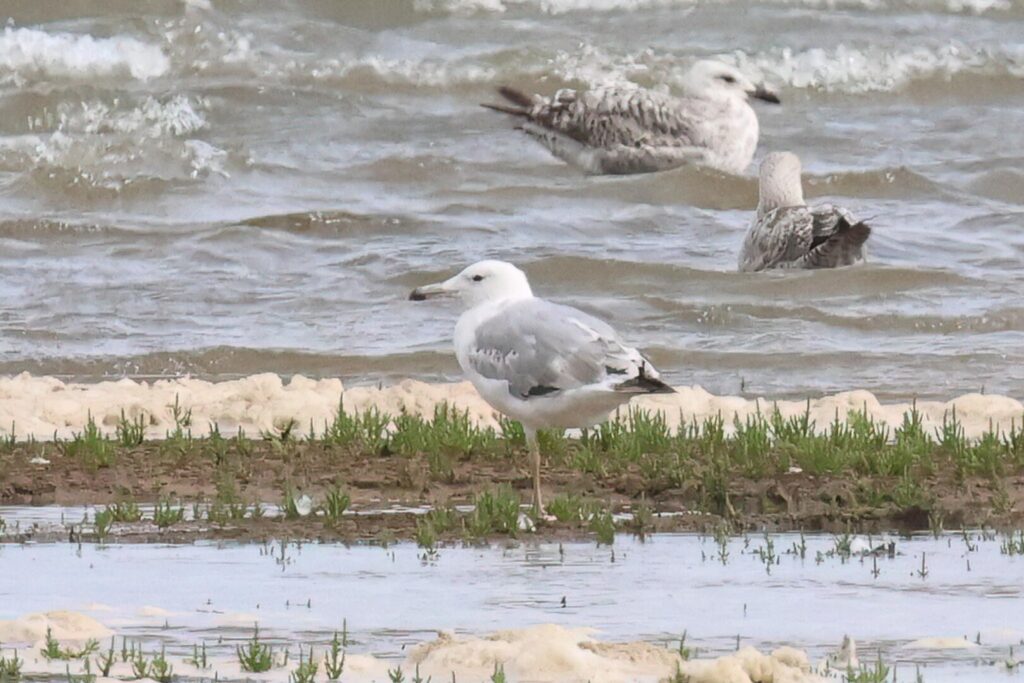
As we started to walk back, we happened to glance behind just in time to see a Cattle Egret flying past over the saltmarsh, before it disappeared off towards Salthouse. A Common Sandpiper called and shot past us in over the channel. It dropped down onto the Fen and from the seawall we could see it feeding on the edge of one of the islands now.
Along the path by the river, a juvenile Marsh Harrier circled overhead making begging calls. There were several Ringlet butterflies in the grass now and Gatekeepers in the shelter between the hedges along the permissive footpath by the road.
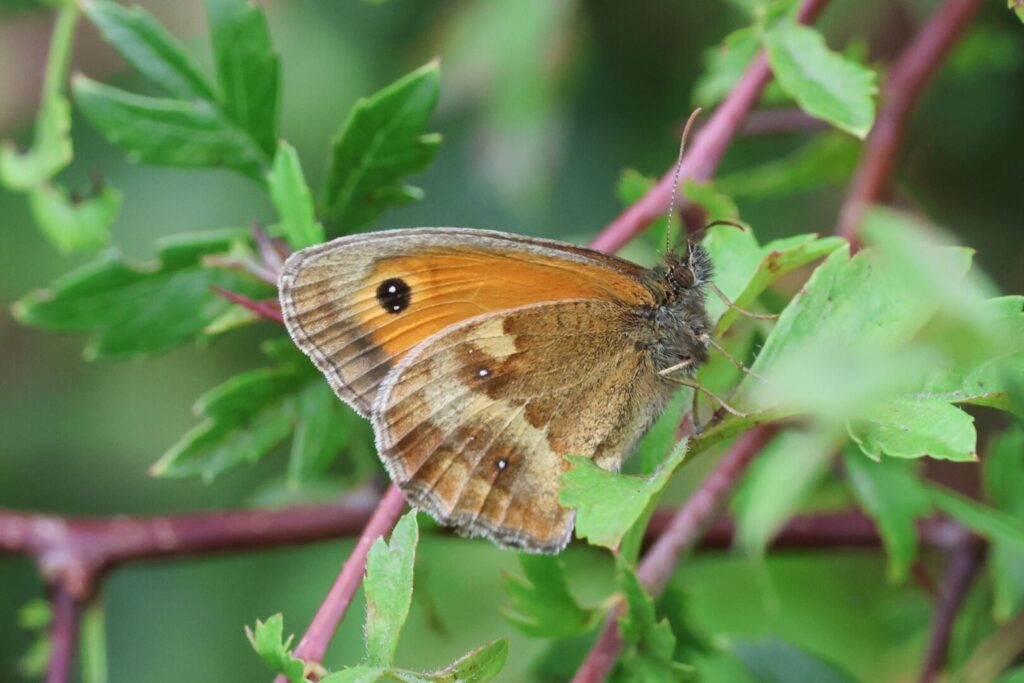
Back in the minibus, we drove on a little further towards the village to find somewhere to turn round. As we passed, we noticed a couple more Cattle Egrets in with the cattle on the grazing meadows. We managed to turn round and as we drove back one was perched on the back of one of the cows. There were no cars coming so we were able to stop briefly and counted at least four Cattle Egrets in the grass.
We drove east to Cley next and after a quick stop to use the facilities at the Visitor Centre we parked in front of Walsey Hills. A family of Coot and a couple of Little Grebes were on Snipes Marsh. At the start of the East Bank, another adult Little Grebe was feeding a pretty much fully grown juvenile, while a second youngster was catching food for itself a bit further back. We could hear a Reed Warbler singing but it was keeping well down out of the wind.
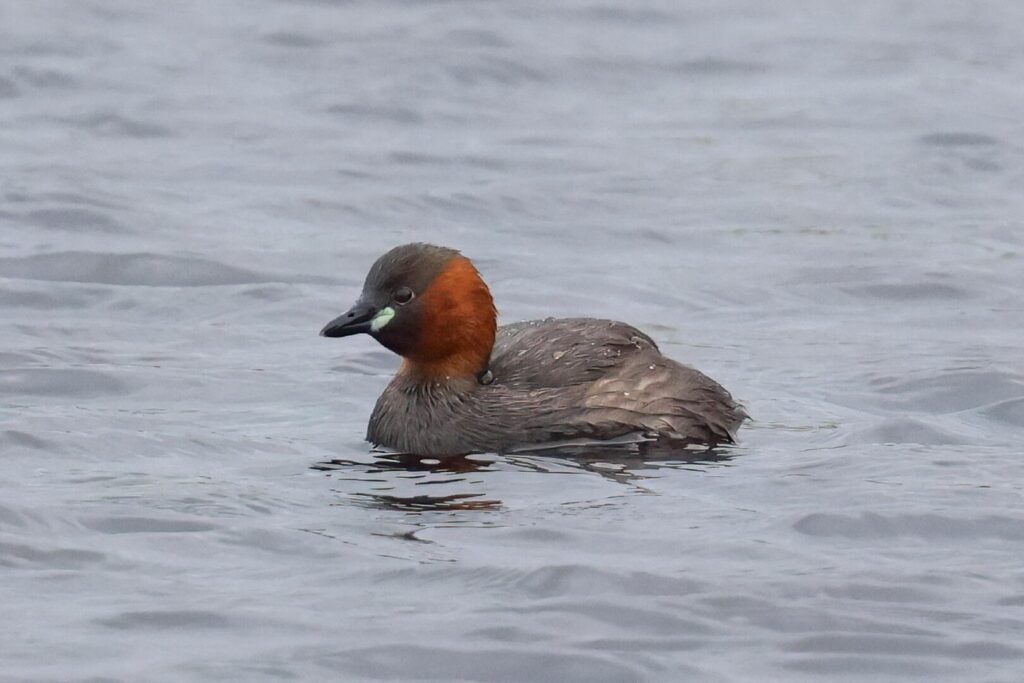
There seemed to be a few waders on the Serpentine, so we walked up for a closer look. A moulting male Ruff and a Lapwing were on the mud. We got the scope on the Ruff for a closer look and a Common Snipe walked out of the grass just behind it. Further up, we found a close Little Ringed Plover, so we could see its golden eye ring in the scope. Further back, there were another two Ruff, different colours and in different stages of moult, not two are alike!

A party of Black-tailed Godwits at the far end, all in rusty breeding plumage, looked very smart. A single Spoonbill was feeding in the water, sweeping its bill from side to side. Several more Teal were hiding in the grass at the back.
It didn’t seem like a promising day for seeing Bearded Tits, it was just too windy for them. We hadn’t heard any on the walk out but now we could hear several calling in the ditch below the path. We followed the sound as they worked their way further up and then a juvenile Bearded Tit perched briefly in the top of the reeds right in front of us. A second juvenile then climbed up into the top of the reeds further back, where we watched it swinging on a reed stem in full view.
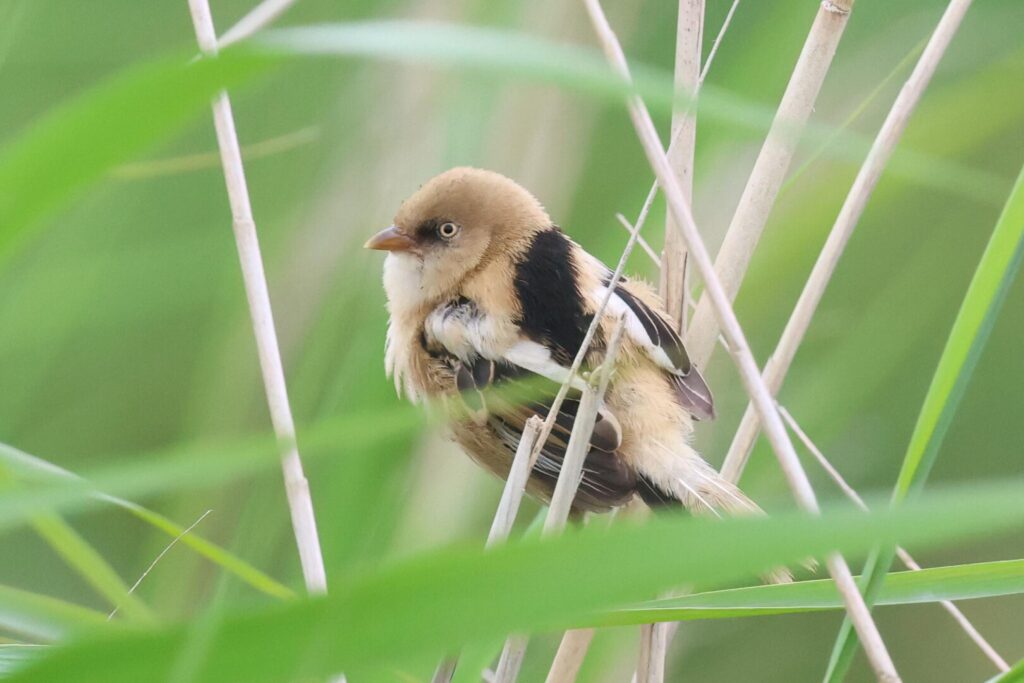
A Sedge Warbler started singing and perched up very obligingly too. Two Great White Egrets flew up out of the reedbed the other side and circled round.
We could hear Sandwich Terns calling on Arnold’s Marsh so we walked on up to the shelter, where we could get out of the wind. We had a good view of them now out roosting on the small shingle islands and standing in the shallow water. There were several juveniles, good to see, as they have been badly affected by bird flu the last two years.
There were several Common Terns too, we could see their black-tipped orange-red bills and slicked back black crowns. A single immature tern was asleep nearby and looked short legged by comparison, but flew off before we could get a good look at it. After the terns all flew round later, we found it again asleep standing in the water. A 1st summer Arctic Tern. Several gulls were loafing on the saltmarsh at the back, including a sleeping Kittiwake.
A few waders were on Arnold’s too today, but not as many as there have been, perhaps due to the wind. We did find a single Bar-tailed Godwit, just moulting out of its rusty breeding plumage, a couple of Curlew, and two or three Ringed Plovers.
Out at the beach, there was no sign of any Gannets passing now. A couple of Sandwich Terns were plunge diving just offshore, with more flying past. It was cold in the wind here so with murmurings of dissent in the ranks we didn’t linger today and turned to head back.
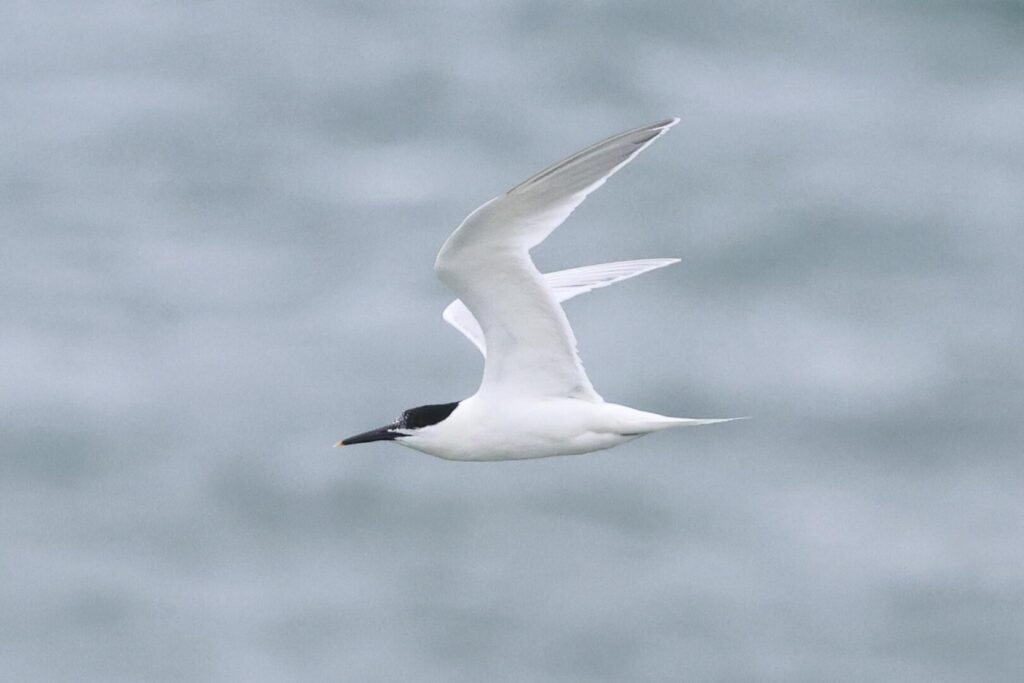
It was time for lunch when we got back to the minibus, so we drove back to the Visitor Centre. We sat out on the picnic tables in front and the weather didn’t seem too bad, but we were just finishing when we could see some very grey cloud coming in. It started to drizzle, so we quickly packed up and retreated to shelter.
The rain blew through quickly, so we made our way round to the Heath. It was not ideal weather for here this afternoon, cool, grey and windy. Unsurprisingly, there were no butterflies feeding around the Viper’s Bugloss by the car park. Further up, we did eventually manage to find a single Silver-studded Blue hiding in the low gorse in one of their regular areas.
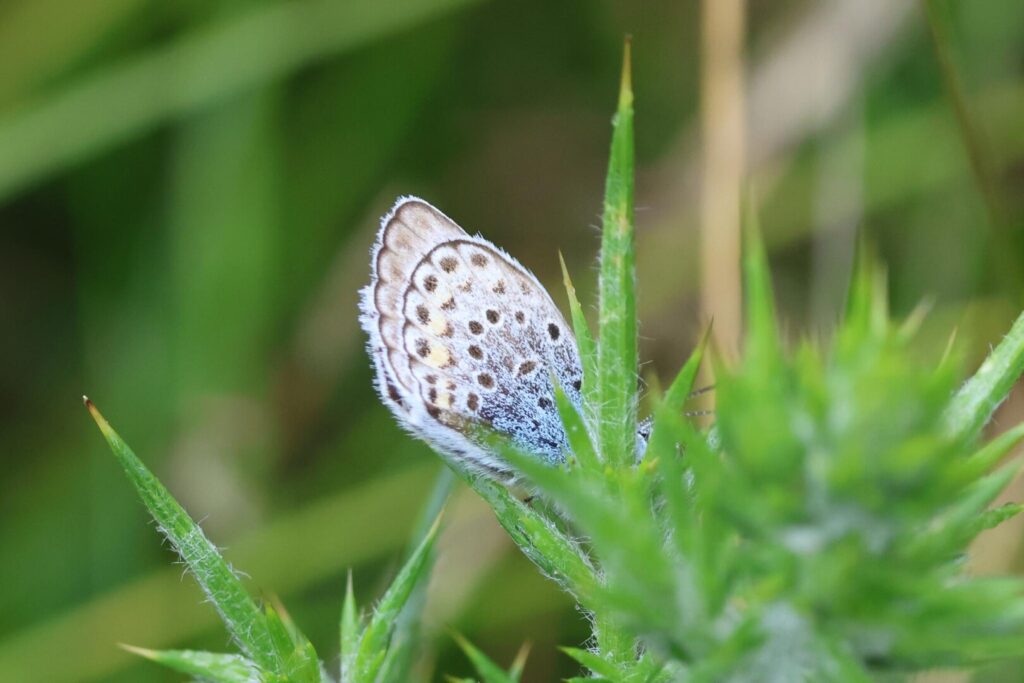
Walking on round, there were few birds active now. We headed straight over to a favoured area, and quickly spotted a Dartford Warbler zip past and disappear into the heather. It came out and we could see it was a male. A second bird appeared, this time a female. We could see they were collecting food, presumably with young in a nest somewhere nearby. After some great views, we retreated and left them in peace.
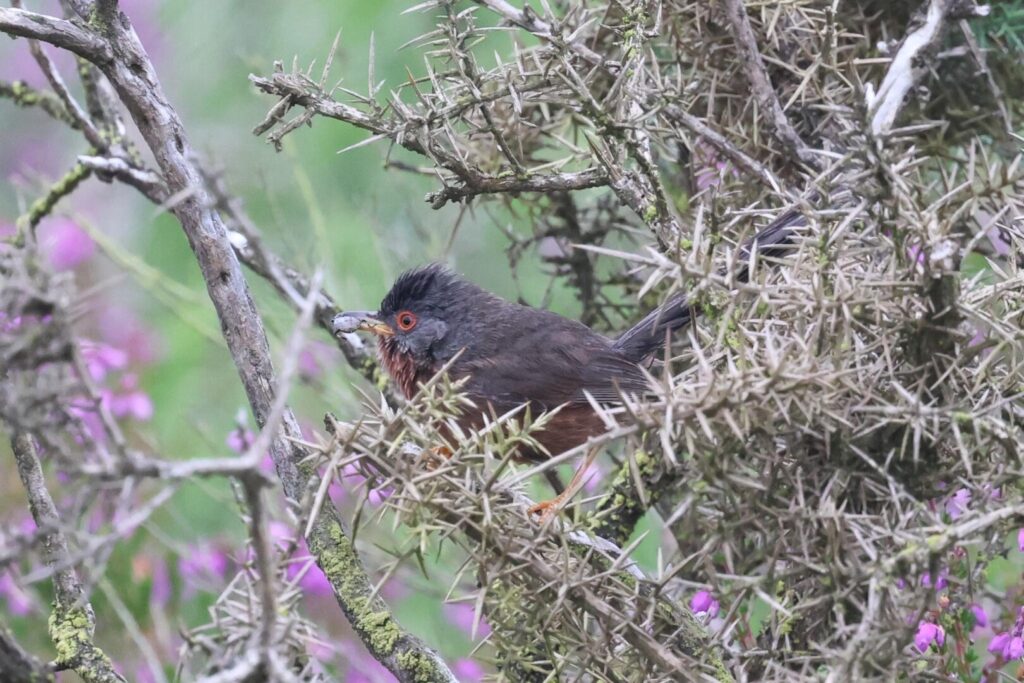
We were hoping for Woodlarks but there was no sign where they have been collecting food earlier this week. We continued on round, checking some other likely spots, and found a Willow Warbler in the birches briefly. Further on we came across another two in an oak tree, an adult collecting food and feeding a fledged begging juvenile. There were lots of Linnets in the gorse and perched on the fence posts. We could hear Yellowhammers calling. A mixed flock of tits worked its way through the birches.
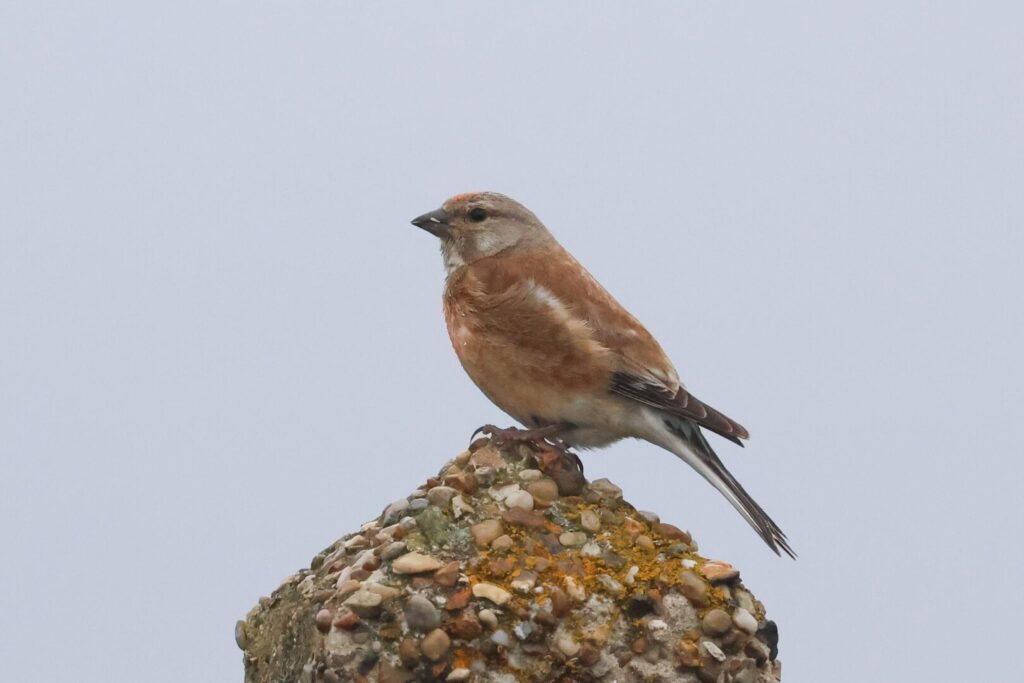
We could see the cloud getting thicker, and as we made our way back round to the car park it started to drizzle. We got back to the minibus just in time as the rain started to fall more heavily. Perfect time to head back for tea and cake.
















